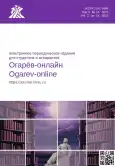Current research views on pitfalls and potentials of the use of technologies in call
- Authors: Puschenreiterová J.
- Issue: Vol 3, No 14 (2015)
- Section: Articles
- Submitted: 18.04.2025
- Accepted: 18.04.2025
- URL: https://ogarev-online.ru/2311-2468/article/view/288285
- ID: 288285
Cite item
Full Text
Abstract
The present study analyses the potentials and pitfalls of the use of the technologies within current research studies on CALL (Computer Assisted Language Learning). The main outcome of the analysis is the fact that many of the researchers and scholars discussing various CALL- connected problems often point to general pitfalls and potentials of the use of technologies in education. It means that not many of the pitfalls and/or the potentials are aimed at foreign language education, but refer to various CAL (Computer Assisted Learning) problems in general.
About the authors
J. Puschenreiterová
Author for correspondence.
Email: ogarevonline@yandex.ru
Russian Federation
References
- Abuseileek A., Abu Sa’aleek A. Computer Assisted Language Learning: Merits and Demerits // Language in India. – 2012. – No. 12(4). – pp 23–36.
- Bani Hani N. Benefits and Barriers of Computer Assisted Language Learning and Teaching in the Arab World: Jordan as a Model // Theory and Practice in Language Studies. – 2014. – Vol. 4, No. 8. – pp. 1609–1615.
- Barani G. Computer Assisted Language Learning in ELT contexts // Modern Journal of Language Teaching Methods. – 2014. – No. 4(1). – pp. 57–66.
- Cabrini S. An overview on the use of new technologies in English language teaching // Acta Scientiarum. Human and Social Sciences. – 2007. – No. 29(1). – pp. 31–34.
- Dina. A-T., Ciornei. S-I. The advantages and disadvantages of computer assisted language learning and teaching for foreign languages // Procedia of Social and Behavioural Sciences. – 2013. –No. 76. – pp. 248–252.
- Linsey, et al. Implications for blended learning from an evaluation of student approaches to learning and studying // Proceedings of the 5th European Conference on e-Learning. – 2005. – pp. 201–209.
- Riasati M.J., Allahyar N., Tan K-E. Technology in Language Education: Benefits and Barriers // Journal of Education and Practice. – 2012. – No. 3(5). – pp 25–30.
- Tafazoli D., Golshan N. Review of Computer-Assisted Language Learning: History, Merits & Barriers // International Journal of Language and Linguistics. Special Issue: Teaching English as a Foreign/Second Language. – 2014. – Vol. 2, No. 4. – pp. 32–38.
- Veselá K. Teaching ESP in New Environments: CA-CLIL. – Nitra: ASPA, 2012. – 113 p.
- Warschauer M. Computer Assisted Language Learning: An Introduction. – URL: http://www.ict4lt.org/en/warschauer.htm#garrett.
- Warschauer M., Healey D. Computers and Language Learning: An Overview // Language Teaching. – 1998. – No. 31. – pp. 57–71.
- Warschauer M. Technological Change and the Future of CALL. – URL: http://books.google.sk/books/about/New_perspectives_on_CALL_for_second_lang.html?id=_ifILDTFVOMC&redir_esc=y.
Supplementary files













